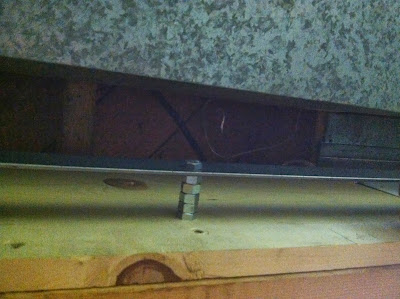Our sliding barn door tutorial :) :) :)
The wood that we used for ours came from The Outlaw's brother. It was previously used as crate cribbing on stuff at his work and sat outside for a few months so it was nice and weathered, and free!
I've seen the exact same cedar wood boards at Lowe's for about $10 a piece, not as attractive as FREE, but if you can't find it, there you go.
Make sure you bring the wood inside, at least a couple days, in advance to acclimatize if you want tight gaps between the boards.
We started by making a sketch of what we wanted it to look like. We had an idea but until we laid out the wood we were not sure.
The boards were a variety of lengths. Instead of measuring each board separately we lined the top edges up and marked one board to length. Then using a square and straight edge marked the rest and cut each on a miter saw.
Using a couple ratchet straps, we squeezed the boards tightly together. Lying the horizontal boards across the vertical and putting your weight on it with a knee will keep the vertical boards flat and buckling inward as you tighten the straps.
Keeping the screws lined up and not random makes it look a little more organized. After this we screwed on all of our horizontal pieces (which we cut to the same measurement as the vertical pieces were wide combined) with 1 1/2" wood screws. After this was done we flipped the door over and screwed threw the vertical into the horizontal pieces. We did this for a better hold and to ensure that the screws would not stick out either side.
For the roller hardware we used a 12'' x 1 1/8" mending plate (TSC) that cost 3.99 each and attached 3"steel garage door pulleys to the plates with the supplied bolts from the pulley kit. I think it cost something like 4.49 for the kit. We placed brackets where we wanted them marked holes and drilled them out for attaching the mending plates.
Again, you don't want anything sticking through to catch on anything, so we used some T nuts on the back side of the door to attach the mending plates. And that was it for the door construction.
Next we had to figure out how to mount a rail for the pulleys to slide on...
We picked up some steel flat stock in the welding department at TSC measuring 11/2"x1/8"x72" for about $8.00. We marked the center of the stock and then marked out every 12" to the ends and drilled a 3/8" hole at each mark. (We had a heavy duty wood slat wall to mount our stock, you may need to find the studs and then drill holes to that criteria)
We held the stock where we wanted it, level of course, and marked each hole. With a 5/16" drill bit we drilled at each mark. Then we used 3/8"x 3 1/2" lag screws, with nuts that slid over the screws as spacers, and hung the steel stock. Depending on how thick the wood is, trim and other factors you may need more or less than our 5 spacer nuts.
Finally we lifted the door and hung it on the steel stock.
As you can see the finished product looks different than the sketch. We toyed around with a horizontal bored across the middle and a cross member from corner to corner but settled on the simple design with the arch accent we cut in with a jig saw. You can get fancy and put whatever design you could think of and cut it out, but there's just something in simplicity.






























barn door hardware kits for interior residential installation. Barn door track has Sliding barn doors are a growing trend in the residential design industry and are excellent space-saving solutions for pantries, laundry rooms, master bathrooms, barn door hardware kits
ReplyDelete